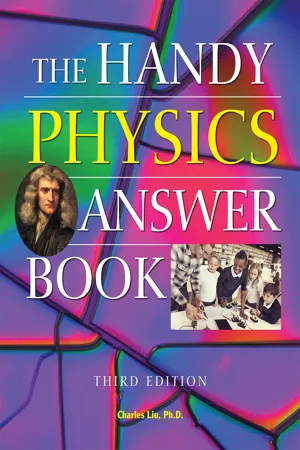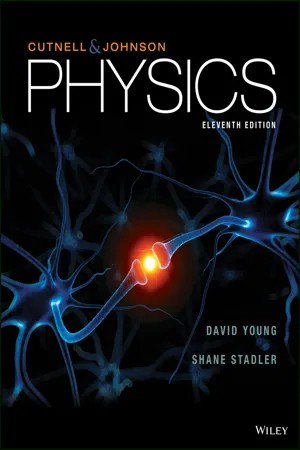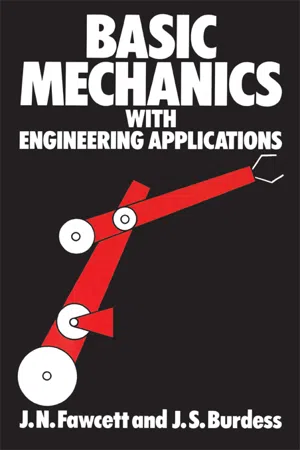Physics
Momentum Change and Impulse
Momentum change refers to the alteration in an object's momentum, which is the product of its mass and velocity. Impulse, on the other hand, is the force applied to an object over a period of time, resulting in a change in its momentum. These concepts are important in understanding how forces affect the motion of objects.
Written by Perlego with AI-assistance
Related key terms
Related key terms
1 of 4
Related key terms
1 of 3
6 Key excerpts on "Momentum Change and Impulse"
- eBook - ePub
- Charles Liu(Author)
- 2020(Publication Date)
- Visible Ink Press(Publisher)
MOMENTUM AND ENERGY
What is momentum?
In physics, momentum is defined as the product of mass and velocity. Momentum is a vector quantity—it has both magnitude and direction. Consider a football player—a lineman. Linemen are massive. If they can run fast, then their mass times their velocity is their momentum (mv). The momentum is in the direction the player is moving.What is the relationship between momentum and force?
If a force is exerted on an object for a limited period of time, the product of that force and that time period is called the impulse of that interaction. Momentum and impulse are mathematically the same thing; to change the momentum of an object, you add an impulse. So, if you want to stop a lineman charging toward you with some momentum, you need to give the lineman an impulse in the opposite direction. The more time you have to push against the lineman, the less force you have to use to produce the same impulse.How does a rocket increase momentum?
A rocket is an excellent example of how momentum is changed in a moving object. A rocket’s engine expels gas backward at a high velocity. The gas, which is originally at rest in the rocket, is thus given a large momentum backward. This, in turn, provides a large impulse forward to the rocket, which is propelled forward because its forward momentum has been increased.Why does a rocket work even if it’s in space and can’t push off the ground?
A common misconception about rockets is that they take off when their exhaust pushes off the ground. It only looks that way when, for example, a space-bound rocket rises off its launchpad. What the rocket exhaust gas does to the ground has no effect, however, on the rocket itself; it’s what the gas does to the rocket that matters, a manifestation of Newton’s Third Law of Motion: for every action (the downward impulse of the gas), there is an equal and opposite reaction (the upward impulse on the rocket). The rocket rises slowly as it overcomes Earth’s gravity, and it accelerates upward as its momentum increases. - eBook - ePub
- John D. Cutnell, Kenneth W. Johnson, David Young, Shane Stadler(Authors)
- 2018(Publication Date)
- Wiley(Publisher)
linear momentum, which is defined as follows:DEFINITION OF LINEAR MOMENTUM
The linear momentum(7.2)p →of an object is the product of the object's mass m and velocityv →:Linear momentum is a vector quantity that points in the same direction as the velocity.p →= mv →SI Unit of Linear Momentum: kilogram · meter/second (kg · m/s)Newton's second law of motion can now be used to reveal a relationship between impulse and momentum. Figure 7.3 shows a ball with an initial velocityapproaching a bat, being struck by the bat, and then departing with a final velocityv →0. When the velocity of an object changes fromv →ftov →0during a time interval Δt, the average accelerationv →fis given by Equation 2.4 asa →¯=a →¯−v →fv →0Δ tAccording to Newton's second law,(7.3)∑the average acceleration is produced by the net average force= mF →¯a →¯∑. HereF →¯∑represents the vector sum of all the average forces that act on the object. Thus,F →¯∑= mF →¯(=)−v →fv →0Δ tm− mv →fv →0Δ tIn this result, the numerator on the far right is the final momentum minus the initial momentum, which is the change in momentum. Thus, the net average force is given by the change in momentum per unit of time.* Multiplying both sides of Equation 7.3 by Δt yields Equation 7.4 , which is known as the impulse–momentum theorem.FIGURE 7.3When a bat hits a ball, an average forceis applied to the ball by the bat. As a result, the ball's velocity changes from an initial value ofF →¯(top drawing) to a final value ofv →0v →f - No longer available |Learn more
- Robert A. Pelcovits, Joshua Farkas(Authors)
- 2023(Publication Date)
- Barrons Educational Services(Publisher)
5Linear Momentum and Center of Mass
Learning Objectives
In this chapter, you will learn:Definition of linear momentumNewton’s second law in terms of momentum; impulseConservation of momentum in the absence of a net external forceElastic and inelastic collisionsCenter of massMotion of the center of massMomentum
Linear momentum is a vector parallel to velocity. Momentum obeys superposition such that the net momentum of a collection of objects is the vector sum of the momentum of each object.The Relationship Between Force and Momentum
Thus, when the net force on an object or system of objects is zero, the net momentum remains constant (it is conserved). Recall from Chapter 3 that internal forces cannot contribute to the net force because they always cancel each other out. (This is a direct consequence of Newton’s third law: Any internal force produces an equal and opposite internal force that cancels it.) Therefore, in the absence of a net external force (Fnet = 0), the total momentum of a body or system of bodies is conserved (even if mechanical energy is not conserved). Mathematically,TIP If the net external force on a system of objects is zero, then the total momentum is conserved.Impulse is defined as follows.If the force is constant, we can put it in front of the integral sign:The Relationship Among Impulse, Force, and Time (Impulse-Momentum Theorem)
Recall from above that Therefore,Relationship between impulse and force: the impulse-momentum theoremOf course, this vector equation can also be written as a set of scalar equations:The Relationship Between Impulse and the Average Force
Applying the calculus formula to calculate the average value of a function,The graphical significance of impulse and average force is shown in Figure 5.1 . The equation tells us that the impulse is the area under the F(t) graph. The average force is this area divided by Δt, which equals the height of a rectangle of width Δt that contains the same area as the integral - eBook - ePub
- Sir James H. Jeans(Author)
- 2013(Publication Date)
- Dover Publications(Publisher)
has disappeared from the total energy. This has been used up in producing motions of the particles of the bullet and target relative to one another; these show themselves in the form of heat, and also, perhaps, partly in permanent changes of shape, — a dent in the target, or a flattening of the bullet.Measure of an Impulse
191. The change of momentum produced by an impulsive force is called the impulse of the force. Thus if an impulse I acts on a mass m , changing its velocity (or component of velocity in the direction of the impulse) from u to v , we have(84)The force acting at any instant is, by the second law, equal to the rate of change of momentum of the particle (or body) on which it acts. If the force is of constant amount, the whole change of momentum is equal to the product of the force by the time over which it acts. If the force is of variable amount, the change of momentum will be equal to the integral of the force with respect to the time over which it acts. Thus if P is the value of the force acting at any instant of the whole time t, we see that the impulseWork done by an Impulse
192. The work done by an impulse I in changing the velocity of a mass m from u to v will bethe increase in the kinetic energy of the mass. Since I = m (v — u - eBook - ePub
- J Jones, J Burdess, J Fawcett(Authors)
- 2012(Publication Date)
- Routledge(Publisher)
6Impulse and momentumBasic Theory6.1 Linear momentumParticleLet us suppose that the absolute velocity of the particle P shown in Fig. 6.1 is ν. If the particle has mass m then the vector quantity defined byis called the linear momentum of the particle. We can see from this definition that the linear momentum vector is in the direction of ν and has a magnitude equal to mv.FIG . 6.1If p is now resolved into components px , py along the reference directions OX and OY thenMoreover, if p is differentiated with respect to time we obtaini.e. the rate of change of the linear momentum of the particle is proportional to its acceleration a. We know from Newton’s Second Law of Motion that an external force, F = ma must be applied to the particle in order to produce this acceleration.When there is no external force applied, F = dp/dt = 0, which shows that the linear momentum of the particle is constant during the motion. This represents another way of saying that when no forces act on the particle it continues to move with uniform velocity in a straight line.Impulse of a forceLet us now consider the force F which is applied to the particle and obtain the integral of F over a time interval from t1 to t2 , so thatThe vector quantity is called the impulse of the force. By substituting eqn (6.3) into eqn (6.4) and integrating we obtainThis vector relationship is presented graphically in Fig. 6.2 which shows the change in the linear momentum, Δp = p2 − p1 of the particle. This is equal to the applied impulse .FIG . 6.2Example 6.1 Figure 6.3 shows two blocks, assumed to be particles, resting on a frictionless horizontal surface. Particle P1 is moving with velocity ν0 and collides with the stationary particle P2 . Let us determine the subsequent motion of the particles. We shall assume that the impact is perfectly elastic and that no energy is lost during the impact.FIG - eBook - ePub
Newtonian Dynamics
An Introduction
- Richard Fitzpatrick(Author)
- 2021(Publication Date)
- CRC Press(Publisher)
) :I =(6.31)( t ) d t .∫ft 1t 2Figure 6.8An impulsive forceIn other words, I is the total area under theConsider a object subject to the impulsive force pictured in Figure 6.8. Newton’s second law of motion yieldsf ( t )curve shown in Figure 6.8.(6.32)= f ,d pd twhere p is the momentum of the object. Integrating the previous equation, making use of the definition (6.31), we obtainΔ p = I .(6.33)Here,Δ p =, where pp f−p iiis the momentum before the impulse, and pfis the momentum after the impulse. We conclude that the net change in momentum of an object subject to an impulsive force is equal to the total impulse associated with that force. For instance, the net change in momentum of the ball bouncing off the wall in Figure 6.7 isΔ p = m. (The initial velocity isu f− m ( −u i) = m (u f+u i)−, because the ball is initially moving in the negative direction.) It follows that the net impulse imparted to the ball by the wall isu iI = m (. Suppose that we know the ball was only in physical contact with the wall for the short time intervalu f+u i)Δ t. We conclude that the average force,f ¯, exerted on the ball during this time interval is(6.34)f ¯=I.Δ tThe previous discussion is only relevant to one-dimensional motion. However, the generalization to three-dimensional motion is fairly straightforward. Consider an impulsive force,f ( t ), that is only non-zero in the short time interval t1 to t2
Index pages curate the most relevant extracts from our library of academic textbooks. They’ve been created using an in-house natural language model (NLM), each adding context and meaning to key research topics.
Explore more topic indexes
Explore more topic indexes
1 of 6
Explore more topic indexes
1 of 4





